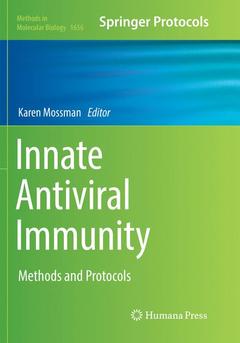Description
Innate Antiviral Immunity, 1st ed. 2017
Methods and Protocols
Methods in Molecular Biology Series, Vol. 1656
Coordinator: Mossman Karen
Language: English
Subjects for Innate Antiviral Immunity:
Support: Print on demand
275 p. · 17.8x25.4 cm · Hardback
Description
/li>Contents
/li>Comment
/li>
The Application of Humanized Mouse Models for the Study of Human Exclusive Viruses.- Zebrafish as a Model for the Study of Host-Virus Interactions.- Northern Blot Detection of Virus-Derived Small Interfering RNAs in Caenorhabditis elegans Using Non-Radioactive Oligo Probes.- Extraction and qPCR-Based Detection of miRNAs from Cultured PBMCs of Bubaline Origin.- Visualizing Virus-Derived dsRNA Using Antibody-Independent and -Dependent Methods.- RNA PAMPs as Molecular Tools for Evaluating RIG-I Function in Innate Immunity.- Methods to Visualize MAVS Subcellular Localization.- Purification of Cyclic GMP-AMP from Viruses and Measurement of Its Activity in Cell Culture.- cGAMP Quantification in Virus-Infected Human Monocyte-Derived Cells by HPLC-Coupled Tandem Mass Spectrometry.- Methods of Assessing STING Activation and Trafficking.- Genome-Wide CRISPR/Cas9 Screening for High-Throughput Functional Genomics in Human Cells.- High Throughput Screening for Identification of Novel Innate Immune Activators.- Chromosome Conformation Capture for Research on Innate Antiviral Immunity.- Discovery of Variants Underlying Host Susceptibility to Virus Infection Using Whole-Exome Sequencing.- Isolation, Purification, and Culture of Primary Murine Sensory Neurons.- Isolation of Group 2 Innate Lymphoid Cells from Mouse Lungs.- Epidemiological Methods.




